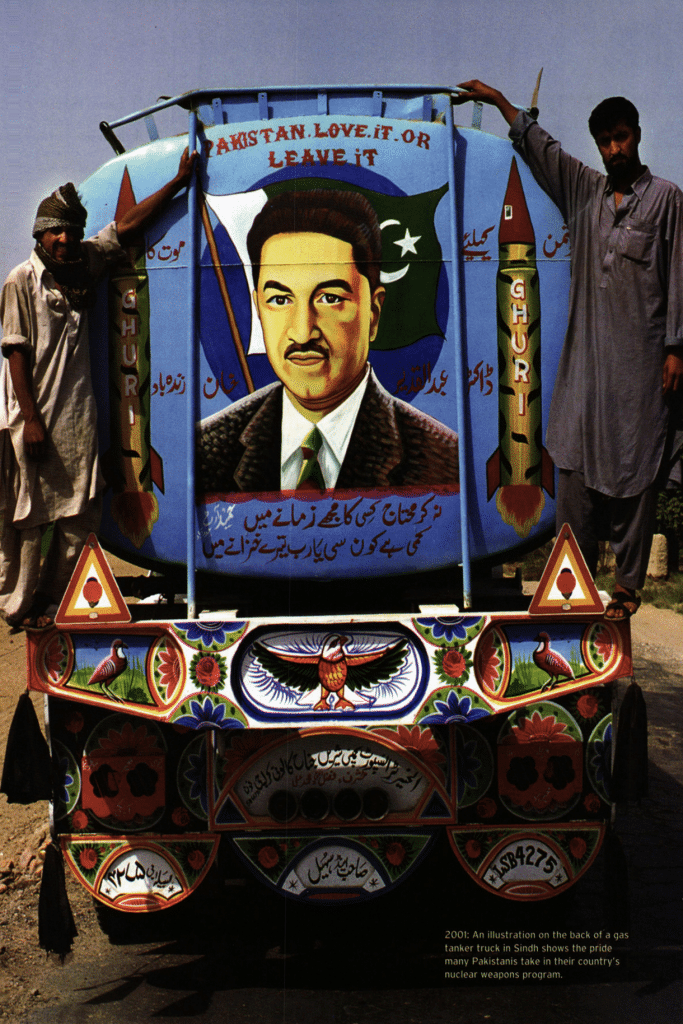On the 20th anniversary of the 1998 nuclear tests by India and Pakistan
By Zia Mian, M.V. Ramana | June 1, 2018

May 2018 marked the 20th anniversary of the nuclear weapon tests by India and Pakistan. Over these past two decades, the Bulletin of the Atomic Scientists has covered the growing nuclear programs of the two countries and the profound risks they pose to the roughly 1.5 billion people now living in these two countries, who make up one-fifth of humanity. Here, guest editors Zia Mian and M.V. Ramana select a few of the many articles on nuclear South Asia that have been published by the Bulletin.
—
On 11 May 1998, Indian Prime Minister A.B. Vajpayee announced that three nuclear devices had been exploded earlier that day. Two days later, following two more explosions, Vajpayee proudly announced that India was now a nuclear weapon state. A couple of weeks later, on May 28 and 30, Pakistan’s Prime Minister Nawaz Sharif announced that his country had conducted six nuclear explosions.
Although the 1998 tests by India surprised much of the world, readers of the Bulletin of the Atomic Scientists had been forewarned. In 1996, one of us (ZM) had written that if the Bharatiya Janata Party (BJP) were to come to power, India might test a thermonuclear weapon, and that Pakistan would welcome the opportunity this might create to test its own nuclear weapons.
The potential use of nuclear weapons has shadowed all military conflicts in the subcontinent since the nuclear tests of 1998. During the conflict over the Kargil region of Kashmir in 1999, the third war over Kashmir, Indian and Pakistani officials delivered indirect and direct nuclear threats at least 13 times. The Bulletin has carried articles that describe the potential impact of nuclear weapon use in South Asia as well as the various technological aspirations and acquisitions of the two countries. These include tactical nuclear weapons for use in the battlefield and ballistic missile defense systems. There also have been articles on Pakistan’s proliferation of nuclear technology, and on the risks from Islamic militant movements.
The Bulletin’s Nuclear Notebook column has tracked the nuclear arsenals of India and Pakistan. For example, in 2002, a Nuclear Notebook column listed just five types of delivery vehicles for India, two aircraft and three short- or medium-range ballistic missiles. In contrast, besides the two aircraft and the three short or medium range missiles, the 2017 update lists at least six separate land-ballistic missiles or sea-based missiles.
The future of nuclear South Asia looks bleak. In 20 years, despite crisis, war, and spiraling nuclear and conventional military forces, the two countries have failed to agree any significant measures to restrain their rivalry. The next round involves both countries putting nuclear weapons at sea. Meanwhile, broad-based peace movements have failed to take hold. The international community, for its part, has moved on to other concerns, until the next crisis.
India seemed to be preparing the ground for a nuclear test. Pakistan seemed not very concerned.
Zia Mian and A. H. Nayyar
For the BJP, nuclear weapons are essential to a powerful, awe-inspiring, and militarist “Hindu India”
Praful Bidwai and Achin Vanaik
Pakistan’s nuclear forces, 2001
Outside experts estimate the country has between 24 and 48 nuclear weapons
Robert S. Norris, William M. Arkin, Hans M. Kristensen, and Joshua Handler
From various sources, we estimate that India has a stockpile of 30-35 nuclear warheads, which it is thought to be expanding.
Robert S. Norris, William M. Arkin, Hans M. Kristensen, and Joshua Handler
Analysis of two important books on India’s emerging nuclear capabilities
George Perkovich
Some of Pakistan’s nuclear scientists believe that the bomb should be shared with all of the Muslim community, even—or especially—with Al Qaeda
David Albright and Holly Higgins
2004: Pakistan: It’s déjà vu all over again
Pakistan lied, stole, and conned its way to becoming a nuclear weapons power. Now it’s doing the same as a nuclear broker. Will the United States do anything about it?
Leonard Weiss
2011: Fatwas for fission: Assessing the terrorist threat to Pakistan’s nuclear assets
Pakistan’s nuclear assets may be tempting targets for terrorists. Experts are split, however, on the actual threat posed.
Charles P. Blair
2012: No first use: The way to contain nuclear war in South Asia
A US-led effort to engage the major nuclear powers in bilateral or multilateral no-first-use pledges would decrease the likelihood that a conflict between India and Pakistan could spin out of control
Lawrence J. Korb, Alexander Rothman
2013: Scientists and an atomic subcontinent
The facts of the nuclear situation in Pakistan and India are, without exaggeration, frightening, in and beyond the subcontinent.
Pervez Hoodbhoy
2014: Battlefield weapons and missile defense: Worrisome developments in nuclear South Asia
Two recent developments in South Asia have increased the risk of an accelerated arms race between India and Pakistan
R. Rajaraman
2016: Self-assured destruction: The climate impacts of nuclear war
Even a “small” nuclear war between India and Pakistan, with each country detonating 50 Hiroshima-size atom bombs as air bursts in urban areas, could produce so much smoke that temperatures would fall below those of the Little Ice Age of the fourteenth to nineteenth centuries, shortening the growing season around the world and threatening the global food supply
Alan Robock and Owen Brian Toon
2016: A warning about Pakistan’s illusion of power
Free discussion and honest opinion about nuclear weapons have been nearly prohibited in Pakistan, under the premise that any such talk poses a basic threat to national security
I.A. Rehman
2016: Taking stock: The US-India nuclear deal 10 years later
The deal has vastly improved US-India trade and defense cooperation but has also aggravated tensions between India and Pakistan and a nuclear arms race between the two countries.
Subrata Ghoshroy
2016: Kashmir, climate change and nuclear war
A new source of conflict between Pakistan and India has emerged. It is a struggle over access to and control over the water in the rivers that start as snow and glacial meltwater in the Himalayas and pass through Kashmir on their way to Pakistan as the Indus River Basin.
Zia Mian
Pakistani nuclear forces, 2016
Pakistan has a nuclear weapons stockpile of 130–140 warheads and appears to have plans to increase its arsenal further
Hans M. Kristensen and Robert S. Norris
India is estimated to have produced enough plutonium for 150–200 nuclear warheads but has likely produced only 120–130
Hans M. Kristensen and Robert S. Norris
Together, we make the world safer.
The Bulletin elevates expert voices above the noise. But as an independent nonprofit organization, our operations depend on the support of readers like you. Help us continue to deliver quality journalism that holds leaders accountable. Your support of our work at any level is important. In return, we promise our coverage will be understandable, influential, vigilant, solution-oriented, and fair-minded. Together we can make a difference.
Topics: Uncategorized















